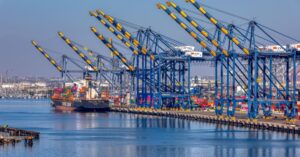Cargo theft continues to rise in North America, reaching 49% in the first half of 2024. Loss per incident has risen over 80%, and California, specifically Southern California, seems to be the hotbed of these activities. Despite the recent turnaround the LTL industry has been experiencing, a couple of major carriers had declining tonnage for the month of August, while margins remained the same due to higher freight prices.
In the latest edition of The Collaborative Logistics Newsletter, where we explore news, trends, and everything else brewing in the logistics market.
North American Cargo Thefts Surge by 49% in 2024
Thieves in the freight market are becoming increasingly organized and targeting high-valued goods at an alarming pace. According to a report from Overhaul, a supply chain risk management firm, cargo thefts in North America rose 49% in the first half of 2024. The financial impact of these criminal activities has also surged.
The average loss per incident rose 83% to $115,230. Electronics lead the list of stolen goods, accounting for 23% of thefts. Other highly targeted items include home and garden products, clothing, and food. California, especially Southern California, has become the epicenter of cargo crime, accounting for 45% of all incidents occurring in the state. Thefts commonly occur near major freight hubs and ports, especially within 200 miles of shipment origins, a zone Overhaul recalled as the “red zone.”
XPO and Old Dominion Report August Tonnage Declines
Following the optimism of a turnaround in the freight market, especially for LTL carriers, industry leaders XPO and Old Dominion reported declining volumes in August. However, both saw continued improvements, which protected the profit margins. XPO reported a 4.6% year-over-year decline in tonnage during August, while Old Dominion Freight Line reported a 6.1% y/y tonnage decline in August 2024.
XPO maintained its margin guidance, citing effective cost management and favorable pricing trends. However, two-thirds of XPO’s freight is tied to the struggling industrial economy. Saia, which had lower margins, saw an 8.2% year-over-year tonnage increase in August, driven by a shift towards retail and lighter freight, although these come with lower margins.
US Companies Shift Manufacturing Out Of China Amid Tariff Wars
As tariffs are weaponized in global trade, US companies are beginning to rethink their reliance on China. For example, Newell Brands, a consumer goods company, has moved production of goods like Sharpie pens and Oster blenders to the US, Mexico, and Southeast Asia to reduce its reliance on China amid the increasing complexities of navigating these tariffs.
Amid the move, CEO Chris Peterson pointed out that the strategic shift will reduce dependence on China and open up more opportunities for innovation and growth. Other companies are seeking alternatives across Asia, especially in the Southeast. Tesla is reconsidering expansion plans due to potential tariffs.
Despite the present challenges, China remains the dominant global manufacturer. However, this can change with continued tariffs, as it would significantly raise product prices and fuel inflation.
E-Commerce Drives Air Cargo Growth Despite Sluggish Economic Growth
Seasonal patterns have proved insignificant for the current air cargo market as Chinese e-commerce platforms such as Temu and Shein drive significant volume increases. The demands from these platforms, which now amount to around 20% of global air cargo, have allowed carriers to effectively disrupt the traditional seasonal patterns in the industry and increase rates.
All of this is happening even amid sluggish economic growth and inflation. However, regulatory scrutiny in the US and Europe may threaten the e-commerce boom. Currently, there are calls to lower de minimis thresholds for US import duties, which currently stands at $800. Although air carriers are on a high, other stakeholders are not benefiting as much from the boom because these companies typically bypass forwarders like Kuehne + Nagel and DSV.
Fed Signals Potential Rate Cuts Amid Cooling Labor Market
In late August, Federal Reserve Chair Jerome Powell indicated a likely reduction of interest rates during its September meeting because of the Fed’s progress in reducing inflation towards its target of 2% and a cooling labor market. In the meeting, he emphasized that although inflation is nearing the Fed’s target, the major focus for policymakers at the moment is preserving job market stability and avoiding excessive job losses.
For now, the decision on the actual figures for the rate cut is uncertain, but most of the market favors a quarter-point reduction. Within a week of the announcement, the odds were at 76% odds of a quarter-point cut and a 24% probability of a half-point cut. Other Fed officials, including Austan Goolsbee and Raphael Bostic, support the reduction; they believe it should be eased into because while inflation has improved, risks remain, and certain economic indicators still signal caution.
For the labor market, they noted that while it is weakening, it is not yet in crisis.
Seamless Shipping With COGISTICS Transportation
COGISTICS Transportation stands out with its customer-centric approach, deep industry knowledge, and commitment to innovative, eco-friendly 3PL solutions. We transform logistics challenges from air, land, and ocean freight operations into strategic advantages around the clock and worldwide. Our commitment to your success is unwavering, focusing on enhancing efficiency, visibility, peace of mind, and expedited freight. Book a meeting with us today.




